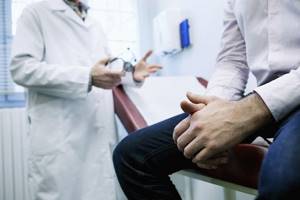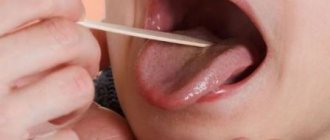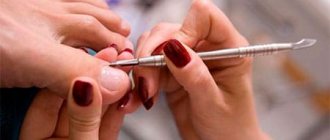Having read on the Internet the complaints of men about their small penis, you come to the conclusion that many are completely unaware of what is considered normal and what is considered a small penis size. 80% of men have an inferiority complex due to penis size only because they do not have correct information about the size of male genital organs.
It’s not customary to ask friends about this. But if someone asked about the size of the penis, then just in case the man will exaggerate, because he does not know the norm. The other one will also exaggerate in response, so as not to seem flawed. And then they both get upset: why do I have a small penis?! This is how myths about normal penis size begin.
Description and where does the “mistake of nature” come from?
In order to understand what to do and how to fix the defect, you need to understand the terminology itself. So: a small sexual organ is a penis with an erect size of no more than 9.5 cm. A micropenis can significantly poison the life of both a boy during puberty and a man when the question of a full intimate life is raised. A small penis also affects reproductive functions. Even if a woman is ready to put up with such a penis from her husband, such sizes can be the cause of infertility for the couple.
Why micropenia develops (reasons):
- congenital anomalies (Pasculani, Del Castillo, Noonan syndromes, cryptorchidism, anorchidism and craniopharyngioma);
- traumatic factor;
- insufficient production of testosterone during puberty;
- lack of 5-alpha reductase.
With a lack of estrogen, after inflammatory processes, with tumors and injuries of the testicles, the size of the penis is also small. Radiation, temperature and drug factors have a noticeable effect on the size of the penis. A thin and small penis can be due to tumors of the adrenal glands, diabetes mellitus and lesions of the hypothalamus and pituitary gland.
A small penis size is accompanied by symptoms such as:
- Female body type.
- Overweight.
- Poor hair growth.
- Constantly depressed state.
- Poor mental development.
- Small size of testicles.
- Concomitant pathologies of internal organs.
All of the above factors accompanying a small genital organ indicate a man’s low reproductive ability and the inability to lead a normal intimate life.
Causes
An erect penis 9.5-10 cm long is not a pathology if there are no previous hormonal disorders or events that led to shortening. This feature of a man is determined by hereditary and constitutional factors. True congenital and acquired HMP often lead to:
- Pathological processes in the testicles
. A small penis can be the result of unsuccessful surgical interventions on the genitals, for example, orchipexy performed for bilateral cryptorchidism at 12-14 years of age, or orchiectomy. Hypogenitalism can provoke congenital underdevelopment of the testicles of any origin, including genetic diseases, bilateral orchitis suffered during puberty, against the background of viral mumps or measles. - Damage to the hypothalamic-pituitary region
. Injuries, some brain surgeries, and cerebellar ataxia initiate a decrease in the production of gonadotropic hormones in men with intact testicles. Radiation therapy for head tumors can cause variable hypothalamic-pituitary disorders. - Pathologies with fibrotic changes
. Peyronie's disease, due to the formation of fibrous plaques in the tunica albuginea and the septum of the cavernous structures, contributes to deformation and shortening of the penis. Similar changes result from the replacement of cavernous tissue with scar tissue against the background of chronic recurrent or acute cavernitis, prolonged priapism, or trauma. - Medical interventions.
Surgical removal of a part of an organ - partial penectomy - is resorted to during the treatment of malignant neoplasms, less often - in case of necrotization of the head due to phimosis, animal bites, and self-mutilation. Excision of plaques in a patient with fibroplastic induration, intracavernous injections, circumcision with excessive excision of the foreskin can cause shortening of the penis.
Possible solutions to the problem
What should a man do if the size of his genital organ is very upsetting? The first thing to do is consult a doctor. For some reason, this option is considered last, but only in this way can we understand the reason for the appearance of a small genital organ and develop possible ways to eliminate the pathology.
In fact, the concepts of “micropenis” and “small penis” can be far from each other. Often a casual ridicule about size is nothing more than a cruel joke, but it seeds a seed of doubt in a man’s head. Trying to refute this fact and prove that it is not so, he is able to go too far and create a problem with his reproductive organ.
Before correcting the injustice of nature, it is important to consult a doctor. Very often, a man only needs the help of a psychologist who will direct his thoughts in the right direction and eliminate the consequences of self-hypnosis.
Before using any products, you should consult your doctor.
Ways to adjust a small male penis:
- Hormonal therapy.
- Surgical intervention.
It is worth clarifying that we are talking specifically about a small penis, and not about a man’s desire to enlarge a normal penis. No creams, drops, pumps or similar products work for such a pathology.
Taking hormonal drugs
Timely diagnosis of small penis syndrome allows the pathology to be corrected even before a man enters adulthood. If there is a lack of testosterone and growth hormone, short courses of drugs can somewhat correct the problem of a small organ in adolescence, but such treatment never leads to tangible results. Hormone therapy is rarely given to a child, as this can cause a number of complications. In adulthood, a course of testosterone treatment can lead to the exact opposite result. Somewhat better dynamics can be observed in adolescents with hypogonadism, but as soon as puberty is completed, the penis will stop growing and testosterone injections will have no effect on its size.
Surgical methods
If hormone therapy does not bring results, then a problem such as a small penis can be solved through surgery. There must be medical indications for the operation; a man should not go under the knife in dubious clinics unless a comprehensive examination is carried out and a decision is made on the advisability of using surgical techniques.
Indications may be as follows:
- Medical.
- Functional.
- Aesthetic.
If in the first two cases the operation is necessary so that the man can use the penis for its intended purpose (urination), then in case of dissatisfaction with his penis in terms of its external attractiveness, he will have to “prove” the need for the operation. It will not do without consulting a psychologist, since there is a group of patients who are ready to enlarge their intimate organs indefinitely, even if nature has awarded them with very impressive “tools.”
The goals of surgery are:
- Penis lengthening.
- Adjust thickness if it is too thin.
- Elimination of erectile dysfunction.
It is believed that the most successful operation is one after which the size of the organ increases by 2-3 cm, however, as practice shows, it is not always possible to enlarge a small male penis that much.
Why is it not always possible for a man to help? The degree of elongation, as well as the assessment of thickening, are not standardized concepts; there are no templates that would allow them to be given any exact numbers.
Penis standards
In diagnosing the penis, the main indicators are: resting stage, maximum stretching, ejaculation. The average norm is considered to be an erection state with parameters of 15-17 cm, a resting state - 7-10 cm. If the phallus is smaller in size, this indicates a violation. They differ in appearance:
- Cylindrical shape - when excited, the circumference of the head and the barrel are identical in size;
- Pointed - the trunk is large and the circumference is smaller;
- Mushroom shape - the head is larger in circumference than the base.
They are also classified according to the following types:
- Fleshy - remains massive at rest; during arousal, rapid filling with blood occurs. The penis may remain in a solid form after ejaculation;
- Stringy—firm at rest and when excited, but thin; can shrink during erection. This state remains for a long time.
For some men, a small penis is a pathology. There are 35% of them, most of which solve this problem. 40% mistakenly believe that their small penis is a disease. This opinion appears due to the lack of data on the norm.
You can independently measure your organ in all three states. It is necessary to measure at moderate heat to avoid reduction at low temperatures. The penis is measured along the back, beginning at the pubis, to the base of the head. The right angle between the organ and the anterior abdominal wall should be maintained.
Results may vary due to:
- Existing infections in humans. If a guy at the time of measurements has an infectious disease such as influenza or ARVI, then it will be difficult to bring the phallus fully into a state of erection;
- Temperatures.
These factors contribute to the reduction in size. If the deviations are more than double, then you should seek help.
Preventive measures
Small penis syndrome can be successfully prevented. This should be done not only by the man himself, but also by his parents during his childhood.
The following measures will help avoid pathology:
- maintaining a healthy lifestyle during pregnancy for a woman expecting a baby. Elimination of hormonal medications, absence of bad habits;
- monitoring the development of a boy if there is a history of relatives with problems with the genital organs;
- absence of uncontrolled introduction into the penis of means to enhance erection;
- monitoring hormonal levels;
- fight stress and excess weight.
According to statistics, cases of a small penis are registered in one newborn boy out of five hundred. But in fact, such a pathology occurs much more often, which is explained by poor diagnosis of such a syndrome due to the low qualifications of specialists in clinics.
What can be done to make diagnosis more timely? Have boys examined at an early age by an andrologist-endocrinologist, since if a problem is detected before the age of 14, the correction of a small male penis will be more successful than in the future.
Diagnostics
Diagnosis of a small penis is based on an analysis of the patient’s complaints, an assessment of the medical history, a physical examination with anthropometry, identification of symptoms of hypogonadism, and determination of the degree of maturation. The examination algorithm is different for children and adults. Diagnostics include:
- X-ray.
Based on radiographs of the hands of adolescents, bone age is assessed based on the timing of ossification of the wrist joint and hand. The absence of visualization of anatomical synostoses in photographs in a 13-14 year old boy indicates a delay in puberty from the normal age and pre-pubertal hypogonadism. Densitometry shows the degree of decrease in bone density and is prescribed when the patient presents late (16-18 years). - Cavernosography.
Used in men with Peyronie's disease, local fibrosis to detect pathological foci, atrophy of the cavernous bodies, and vascular changes. Additionally, an intracavernous test is performed with the introduction of vasoactive substances. - MRI of the brain.
Shows the inflammatory, tumor process in the area of the anterior pituitary gland or hypothalamus, the relationship of the neoplasm with neighboring tissues. CT is less informative in detecting brain tumors. - Ultrasound scanning
. Ultrasound of the genitals allows you to detect testicular hypotrophy, cryptorchidism, and determine the true size of the corpora cavernosa with a false small phallus. Ultrasound of the prostate with hypogonadism that developed in prepuberty demonstrates its underdevelopment. - Study of hormonal levels
. Before the onset of puberty, analysis of sex hormones is uninformative without stimulating tests. Primary GG is supported by an increase in the gonadotropins LH and FSH in the blood; secondary GG is indicated by a decrease in their levels. Serum testosterone is often below normal in both cases. A high level of prolactin is suspicious for prolactinoma, estradiol is suspicious for an estrogen-producing tumor of the testicle or adrenal gland. - Spermogram.
The study of ejaculate is carried out after puberty. The results show azoospermia or oligospermia; with total testicular atrophy, sperm cannot be obtained.
Differentiation of a small penis in a man is carried out with micropenis, agenesis, buried and membranous organ, constitutional retardation of growth and maturation, and other diseases. To exclude genetic syndromes, it may be necessary to consult a geneticist and evaluate the karyotype to exclude chromosomal defects.
Reviews from doctors and men
- Gennady Polozkov, 37 years old. Size is important if the penis is smaller than normal. Then, of course, you need to turn to medications and even surgeons. Okay, now there are different methods. And if everything is within the normal range, then others need to take it: with charm and gallantry.
- Elena Polyakova (therapist). A size that is within the average size and will be suitable for fertilization. The problem can only arise with a “micro penis” size. Therefore, if pregnancy does not occur, you and the girl need to undergo examination. It is possible that the reason is different.
Treatment of small penis syndrome
Therapeutic measures are aimed at possibly eliminating the cause of hypopenia. If other endocrine pathologies are identified, the underlying disease is treated. In adults, it is possible to correct some manifestations of hypogonadism due to hormonal imbalance. Urologists-andrologists and endocrinologists treat small penises.
Conservative therapy
If normal levels of hormones in the blood are confirmed, drug treatment is not carried out. Penile dysmorphophobia requires consultation with a psychiatrist. If hypogonadism is an independent pathology or part of a symptom complex, hormone replacement therapy is indicated. Depending on the nature of the pathology, the following is prescribed:
- Androgens.
Indicated for SIPS with primary and secondary HS. Treatment begins at 13.5-15 years with intact testicles and at 11-12 years with rudimentary testicles. Minimum dosages at the first stage imitate natural ripening and prevent early closure of growth zones. The level of testosterone in the blood should be in the range of 13-33 nmol/l, otherwise the dose is adjusted. - Gonadotropins (hCG) and androgens.
Used to enlarge the penis and correct hypogonadotropic GG. The use of androgens can lead to infertility. Beginning therapy with FSH simulates the onset of maturation of Sertoli cells during puberty and helps establish their relationship with Leydig cells, which is important for maintaining spermatogenesis in the future. There are several treatment regimens for gonadotropins; various combinations of FSH and hCG are used.
Prevention

Shortening the duration of sexual intercourse can be prevented. To this end, follow some recommendations:
- making love with a regular partner;
- maintaining proper nutrition;
- maintaining an active lifestyle;
- treatment of provoking diseases of the genitourinary organs;
- normalization of work and rest regimes.
The time from the beginning of sexual intercourse to ejaculation is individual in each case. Seeing a doctor is recommended in cases where sex does not bring satisfaction, when you really want it, causes other discomfort, or if the time of sexual intercourse is less than 1 minute.
Conclusion
There is no need to close yourself off. Any pathological condition can be treated if the problem is approached in a timely and correct manner. In addition, coitus is treatable and has a favorable prognosis.









